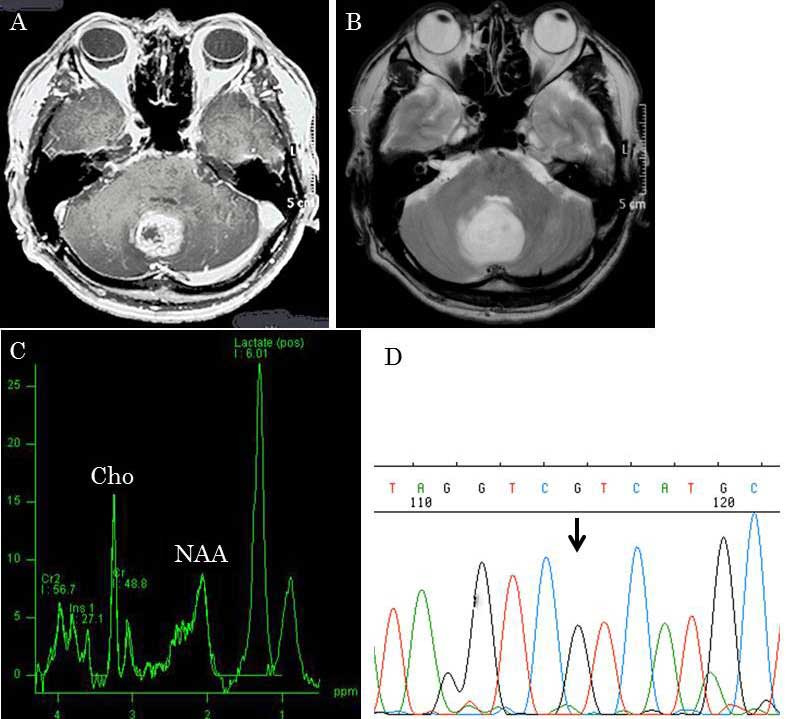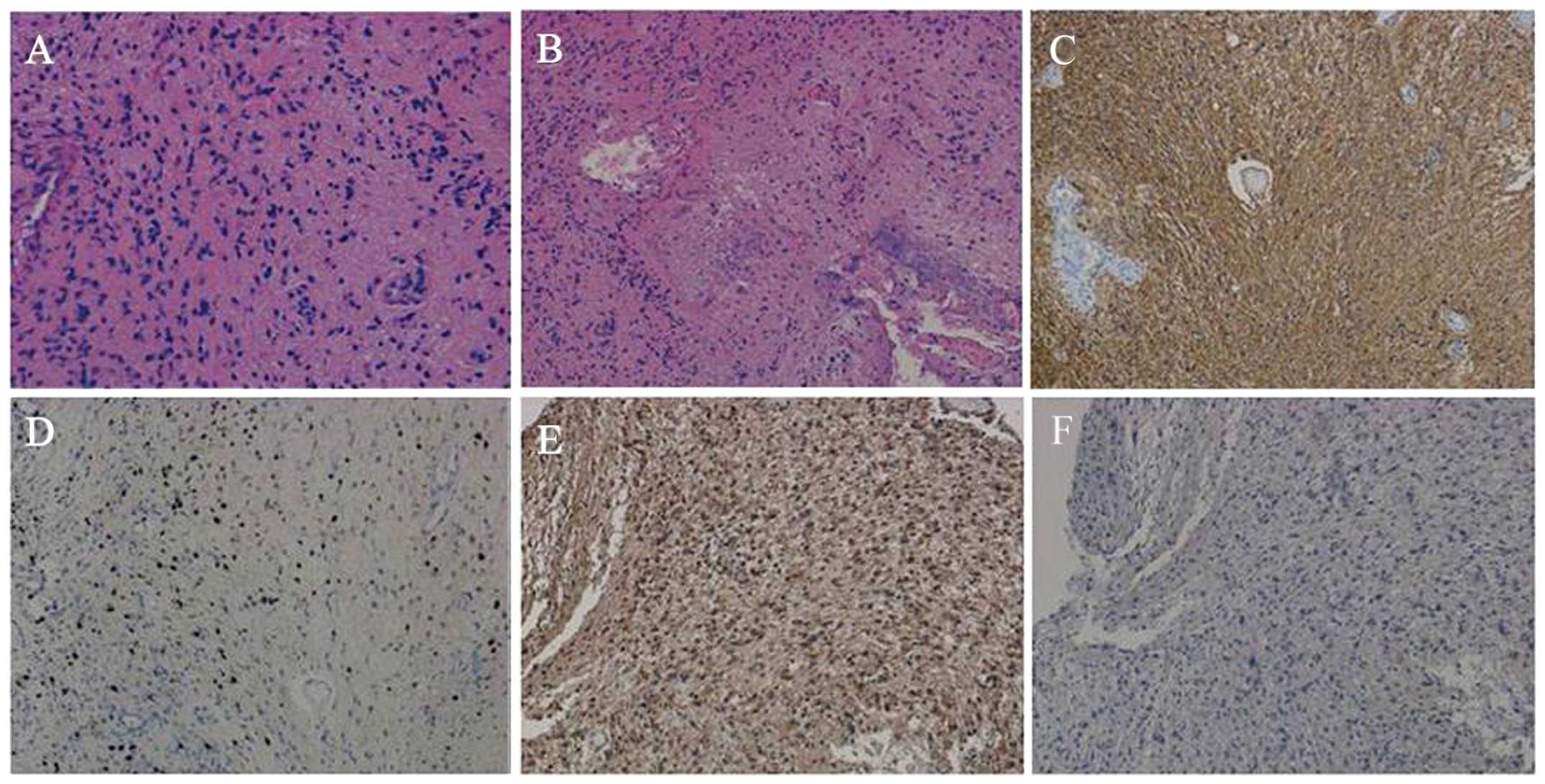|
1
|
Roth JG and Elvidge AR: Glioblastoma
multiforme: a clinical survey. J Neurosurg. 17:736–750. 1960.
View Article : Google Scholar : PubMed/NCBI
|
|
2
|
Grahovac G, Tomac D, Lambasa S, et al:
Cerebellar glioblastomas: pathophysiology, clinical presentation
and management. Acta Neurochir (Wien). 151:653–657. 2009.
View Article : Google Scholar : PubMed/NCBI
|
|
3
|
Salazar OM: Primary malignant cerebellar
astrocytomas in children: a signal for postoperative craniospinal
irradiation. Int J Radiat Oncol Biol Phys. 7:1661–1665. 1981.
View Article : Google Scholar
|
|
4
|
Kleihues P and Ohgaki H: Primary and
secondary glioblastomas: from concept to clinical diagnosis.
Neuro-Oncol. 1:44–51. 1999.PubMed/NCBI
|
|
5
|
Ohgaki H and Kleihues P: Genetic pathways
to primary and secondary glioblastoma. Am J Pathol. 170:1445–1453.
2007. View Article : Google Scholar : PubMed/NCBI
|
|
6
|
Nobusawa S, Watanabe T, Kleihues P, et al:
IDH1 mutations as molecular signature and predictive factor of
secondary glioblastomas. Clin Cancer Res. 15:6002–6007. 2009.
View Article : Google Scholar : PubMed/NCBI
|
|
7
|
Weber DC, Miller RC, Villà S, et al:
Outcome and prognostic factors in cerebellar glioblastoma
multiforme in adults: a retrospective study from the rare cancer
network. Int J Radiat Oncol Biol Phys. 66:179–186. 2006. View Article : Google Scholar : PubMed/NCBI
|
|
8
|
Tsung AJ, Prabhu SS, Lei X, Chern JJ,
Benjamin Bekele N and Shonka NA: Cerebellar glioblastoma: a
retrospective review of 21 patients at a single institution. J
Neurooncol. 105:555–562. 2011. View Article : Google Scholar : PubMed/NCBI
|
|
9
|
Lammert M, Friedman JM, Kluwe L, et al:
Prevalance of neurofibromatosis 1 in German children at elementary
school enrollment. Arch Dermatol. 141:71–74. 2005. View Article : Google Scholar : PubMed/NCBI
|
|
10
|
Easton DF, Ponder SM, Huson SM, et al: An
analysis of variation in expression of neurofibromatosis (NF) type
1 (NF1): evidence for modifying genes. Am J Hum Genet. 53:305–313.
1993.PubMed/NCBI
|
|
11
|
Brown PD, Buckner JC, O’Fallon JR, et al:
Adult patients with supratentorial pilocytic astrocytomas: a
prospective multicenter clinical trial. Int J Radiat Oncol Biol
Phys. 58:1153–1160. 2004. View Article : Google Scholar : PubMed/NCBI
|
|
12
|
Canesso A, Gardiman M, Salmaso R, et al:
An unusual case of malignant pilocytic astrocytoma occurring in the
eye. Virchows Arch. 449:248–252. 2006. View Article : Google Scholar : PubMed/NCBI
|
|
13
|
Gilles FH, Sobel EL, Tavaré CJ, et al:
Age-related changes in diagnoses, histological features, and
survival in children with brain tumors: 1930–1979. The Childhood
Brain Tumor Consortium. Neurosurgery. 37:1056–1068. 1995.PubMed/NCBI
|
|
14
|
Roessler K, Bertalanffy A, Jezan H, et al:
Proliferative activity as measured by MIB-1 labeling index and
long-term outcome of cerebellar juvenile pilocytic astrocytomas. J
Neurooncol. 58:141–146. 2002. View Article : Google Scholar
|
|
15
|
Cawthon RM, Weiss R, Xu GF, et al: A major
segment of the neurofibromatosis type 1 gene: cDNA sequence,
genomic structure, and point mutations. Cell. 62:193–201. 1990.
View Article : Google Scholar : PubMed/NCBI
|
|
16
|
Xu GF, Lin B, Tanaka K, et al: The
catalytic domain of the neurofibromatosis type 1 gene product
stimulates ras GTPase and complements ira mutants of
S.cerevisiae. Cell. 63:835–841. 1990. View Article : Google Scholar : PubMed/NCBI
|
|
17
|
Zhu Y, Guignard F, Zhao D, et al: Early
inactivation of p53 tumor suppressor gene cooperating with NF1 loss
induces malignant astrocytoma. Cancer Cell. 8:119–130. 2005.
View Article : Google Scholar : PubMed/NCBI
|
|
18
|
Klériga E, Sher JH, Nallainathan SK, et
al: Development of cerebellar malignant astrocytoma at site of a
medulloblastoma treated 11 years earlier. Case report. J Neurosurg.
49:445–449. 1978.PubMed/NCBI
|
|
19
|
Cohen MS, Kushner MJ and Dell S: Frontal
lobe astrocytoma following radiotherapy for medulloblastoma.
Neurology. 31:616–619. 1981. View Article : Google Scholar : PubMed/NCBI
|
|
20
|
Furuta T, Sugiu K, Tamiya T, et al:
Malignant cerebellar astrocytoma developing 15 years after
radiation therapy for a medulloblastoma. Clin Neurol Neurosurg.
100:56–59. 1998.PubMed/NCBI
|
|
21
|
Nakamizo A, Nishio S, Inamura T, et al:
Evolution of malignant cerebellar astrocytoma at the site of a
treated medulloblastoma: report of two cases. Acta Neurochir
(Wien). 143:697–700. 2001. View Article : Google Scholar : PubMed/NCBI
|
|
22
|
Osumi AK, Mclendon RE, Tien RD, et al:
Well differentiated astrocytoma occurring nine years after
radiation therapy for medulloblastoma. Clin Neuropathol.
13:281–285. 1994.PubMed/NCBI
|
|
23
|
Pearl GS, Mirra SS and Miles ML:
Glioblastoma multiforme occurring 13 years after treatment of a
medulloblastoma. Neurosurgery. 6:546–551. 1980.PubMed/NCBI
|
|
24
|
Safneck JR, Napier LB and Halliday WC:
Malignant astrocytoma of the optic nerve in a child. Can J Neurol
Sci. 19:498–503. 1992.
|
|
25
|
Schmidbauer M, Budka H, Bruckner R, et al:
Glioblastoma developing at the site of a cerebellar medulloblastoma
treated 6 years earlier. Case report. J Neurosurg. 67:915–918.
1987.PubMed/NCBI
|
|
26
|
Paulino AC, Mai WY, Chintagumpala M, et
al: Radiation-induced malignant gliomas: is there a role for
reirradiation? Int J Radiat Oncol Biol Phys. 71:1381–1387. 2008.
View Article : Google Scholar : PubMed/NCBI
|
|
27
|
Utsuki S, Oka H, Miyajima Y, et al: Adult
cerebellar glioblastoma cases have different characteristics from
supratentorial glioblastoma. Brain Tumor Pathol. 29:87–95. 2012.
View Article : Google Scholar
|
|
28
|
Saito T, Hama S, Kajiwara Y, et al:
Prognosis of cerebellar glioblastomas: correlation between
prognosis and immunoreactivity for epidermal growth factor receptor
compared with supratentorial glioblastomas. Anticancer Res.
26:1351–1357. 2006.
|
|
29
|
Akimoto J, Fukami S, Tsutsumi M, et al:
Radiopathological characteristics of cerebellar malignant glioma in
adults. Brain Tumor Pathol. 26:59–68. 2009. View Article : Google Scholar : PubMed/NCBI
|
|
30
|
Balss J, Meyer J, Mueller W, et al:
Analysis of the IDH1 codon 132 mutation in brain tumors. Acta
Neuropathol. 116:597–602. 2008. View Article : Google Scholar : PubMed/NCBI
|
|
31
|
Gravendeel LA, Kloosterhof NK, Bralten LB,
et al: Segregation of non-p.R132H mutations in IDH1 in distinct
molecular subtypes of glioma. Hum Mutat. 31:E1186–E1190. 2010.
View Article : Google Scholar : PubMed/NCBI
|
|
32
|
Ichimura K, Pearson DM, Kocialkowski S, et
al: IDH1 mutations are present in the majority of common adult
gliomas but are rare in primary glioblastomas. Neuro Oncol.
11:341–347. 2009. View Article : Google Scholar : PubMed/NCBI
|
|
33
|
Sanson M, Marie Y, Paris S, et al:
Isocitrate dehydrogenase 1 codon 132 mutation is an important
prognostic biomarker in gliomas. J Clin Oncol. 27:4150–4154. 2009.
View Article : Google Scholar : PubMed/NCBI
|
|
34
|
Sonoda Y, Kumabe T, Nakamura T, et al:
Analysis of IDH1 and IDH2 mutations in Japanese glioma patients.
Cancer Sci. 100:1996–1998. 2009. View Article : Google Scholar : PubMed/NCBI
|
|
35
|
van den Bent MJ, Dubbink HJ, Marie Y, et
al: IDH1 and IDH2 mutations are prognostic but not predictive for
outcome in anaplastic oligodendroglial tumors: a report of the
European Organization for Research and Treatment of Cancer Brain
Tumor Group. Clin Cancer Res. 16:1597–1604. 2010.
|
|
36
|
Watanabe T, Nobusawa S, Kleihues P, et al:
IDH1 mutations are early events in the development of astrocytomas
and oligodendrogliomas. Am J Pathol. 174:1149–1153. 2009.
View Article : Google Scholar : PubMed/NCBI
|
|
37
|
Weller M, Felsberg J, Hartmann C, et al:
Molecular predictors of progression-free and overall survival in
patients with newly diagnosed glioblastoma: a prospective
translational study of the German Glioma Network. J Clin Oncol.
27:5743–5750. 2009. View Article : Google Scholar
|

















